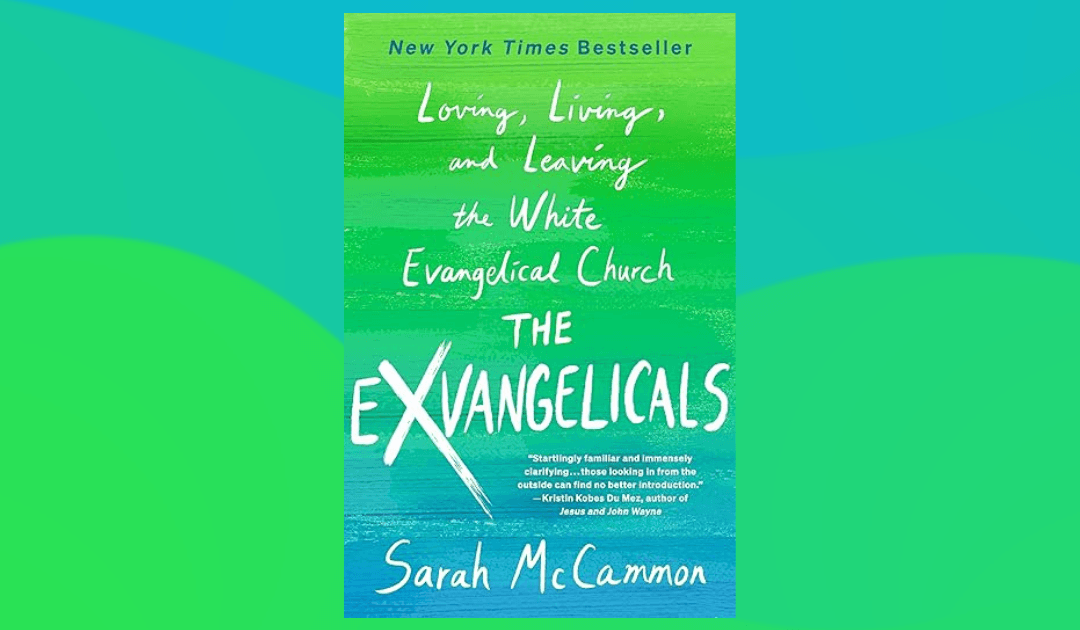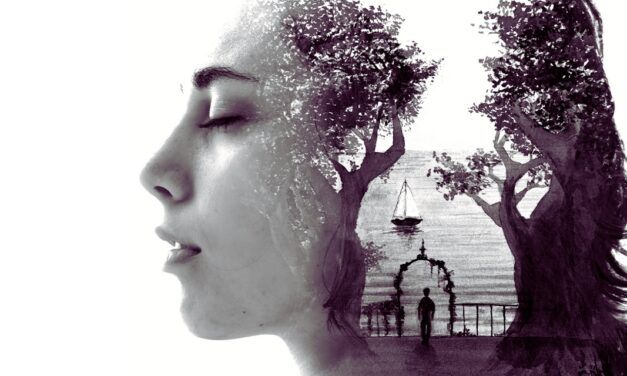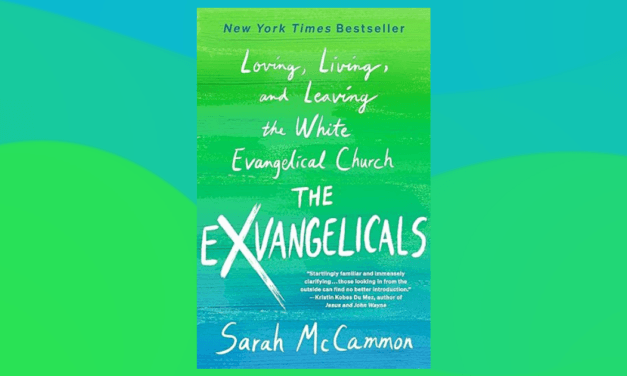This is an online article from the Christian Research Journal. This is also part of an ongoing column entitled, “Theological Trends”.
When you support the Journal, you join the team and help provide the resources at equip.org that minister to people worldwide. These resources include our ever-growing database of more than 2,000 articles, as well as our free Postmodern Realities podcast.
Another way you can support our online articles is by leaving us a tip. A tip is just a small amount, like $3, $5, or $10, which is the cost of a latte, lunch out, or coffee drink. To leave a tip, click here
Book Review
Sarah McCammon
The Exvangelicals: Loving, Living, and Leaving the White Evangelical Church
St. Martin’s Press, 2024
Since the infamous moment when the votes told that Donald Trump had won the 2016 presidential election and that he had been carried to power on a tide of “white evangelical voters,”1 evangelicalism in the US has been undergoing an uncomfortable reckoning it was ill-prepared to endure. This reckoning includes sizable numbers of church-goers not returning to in-person observance following lockdown,2 headshaking scorn across social and mainstream media, and a slew of tell-all memoirs, sociological analyses, and attempts to detail the historical record. Sarah McCammon’s The Exvangelicals: Loving, Living, and Leaving the White Evangelical Church (New York: St. Martin’s Press, 2024) represents, for me, the apex of the genre. Narrating relevant anecdotes from her evangelical childhood, McCammon skillfully weaves her story together with sociological data and interviews of former evangelicals. Her emphatic conclusion: American evangelicalism actually causes harm.
What to Do about the Lost — Declare There Aren’t Any. McCammon grew up in Kansas City, one of four children to parents who belonged to a charismatic congregation called Full Faith Church of Love.3 The picture McCammon paints of her childhood will be largely recognizable for most evangelicals who’ve lived through the 80s, 90s, and early 2000s. She attended Christian school and Christian college. Her parents read Dare to Discipline4 and consumed a steady diet of Focus on the Family. She wore a purity ring, memorized Scripture, was dedicated as a baby, learned about the dangers of believing in evolution, and felt a constant sense of guilt for not sharing her faith with the lost.
McCammon’s world was narrow. Between church and school, she did not have many opportunities to encounter people who were not already believers. Once she agonized over bringing up the question of faith with a friend in her ice skating class (p. 26). Much later, as a Senate page in DC, she felt alone as a professing Christian and endured the shame of being discovered reading her Bible (58). But it was her parents’ posture toward her unsaved grandfather, who she discovered to be a practicing partnered homosexual (124), that ultimately brought about her exit from evangelicalism.
McCammon, as a child, didn’t understand why her family prayed so anxiously for “grandpa” night after night, nor why they saw him so rarely. She loved his beautiful house and knew he was a successful surgeon and accomplished musician. How could he be “lost” when he was so happy, especially, as she discovered much later, having found love with another man following the death of her grandmother?
Trying to make sense of how people could be “lost” from God forever ultimately proved too difficult. It was a relief, McCammon writes, to let go of any need to share news about Jesus with anyone. She reconciled with her grandfather before his death, communicating this decision to her parents in a series of painful interactions.
What to Do about the Fear of Hell — Decide There Isn’t Any. When asked by a friend, “Do you believe that because I’m Muslim, I’m going to Hell?” (59), McCammon suddenly discovered that she didn’t. She writes:
I looked at Sina and thought about how much I liked him and respected him, and how grateful I was for his kindness. I thought about what every major authority figure in my life had told me, again and again: that Jesus says, in John 14:6, “I am the way, the truth, and the life; no one comes to the Father except through me.” The answer, from what I’d been taught, should have been as simple and clear as the question. But I couldn’t bring myself to say it, because for the first time I really had to look squarely at the fact that I wasn’t sure I believed it. I couldn’t look at my friend and say, “I believe my God will send you to Hell because you don’t believe as I do.” He’d called my bluff. I could only muster, “I don’t know. I think it’s between you and God.” I worried, had I failed? Had I wasted an opportunity to save a soul? And yet, somewhere deep inside, my answer felt right. (60)
Being able to trust her own feelings, her sense of things, was part of McCammon’s work of deconstruction. As an evangelical, she had been taught not to lean on her own understanding. Her mother sang a simple chorus as she kept house and took care of Sarah and her siblings — “Trust in the Lord with all your heart” (Proverbs 3:5) (79). This verse, writes McCammon, and others like it, made her feel like she was being “asked to perform a total system override, to ignore and silence the blaring alarms and hand over the keys to my mind to an outside authority. I would always come back to the idea that these doubts were simply ‘my own understanding’ getting in the way” (81).
McCammon, though, wasn’t equipped to work through the apparent contradiction, nor cognitive dissonance, of trying to map her internal intuition over unseen spiritual truth claims. The question of truth ultimately became subservient, for her and many others, to her feelings. But that process wasn’t linear or comfortable. “I was so scared of believing a lie,” said one exvangelical McCammon interviewed. “Of believing something that wasn’t true, or hurting God’s heart, doing something wrong, believing something bad. There’s so much fear” (73). The fear gradually subsides, however, as relief over not having to worry about the eternal destiny of oneself or others takes hold.
What to Do about the LGBTQ Community — Accept Them. If there is one theological shoal upon which the vast majority of former evangelicals are shipwrecking their faith, it is that of sexuality. “Eventually,” writes McCammon, “my support for my grandfather’s ‘lifestyle’ became an ongoing source of tension between my parents and me. One Christmas years ago, in a tearful conversation in the family room where I’d spent much of my childhood, I worked up the courage to tell them how I really felt — that I supported gay rights, and that I regretted being kept away from my grandfather all those years” (135). For a while, McCammon’s mother continued to bring the issue up, to send letters and articles to her daughter. The trouble, for McCammon, is that her mother “believes that God designed the world in a particular way — that a family, led by a man married to a woman, is the ideal for human thriving, and that anything short of that is less than God’s best for humanity, and worthy of God’s judgment” (137).
The issue, as always, revolved around differing views of love. McCammon’s mother admonished her to offer both “friendship and truth” to those living outside the biblical sexual mandate. “To do anything else,” she wrote her daughter, “to confuse right and wrong, is to cause them to stumble. Friends encourage what is good” (137). “Ultimately for me,” writes McCammon, “it came down to love: love for my grandfather, and for the LGBTQ+ friends and colleagues I’d begun to meet as I discovered outside of what Daniel [a friend and interviewee] calls the ‘bubble.’” This view of love made it “difficult to defend biblical literalism.” But ultimately, McCammon was just tired, “tired of trying to hold on to beliefs that felt harmful” (138). She found the language she needed from Chrissy Stroop, a man who left an evangelical church and identified as a woman.5
Tragically, McCammon ends the book not only having denied the existence of hell, and the need for the gospel, but the resurrection of the dead. The entire contents of the Christian faith discarded, she hopes that she will be able, one day, to die as peacefully as her grandfather:
I’ve relaxed, most of the time, into the understanding that I didn’t have to save Grandpa, and that I don’t have to save anyone. That I, like everyone else, was somehow born naked into this world, knowing nothing, a tiny bundle of flesh and blood and bones pulsating with needs and desires — and that someday if I’m very fortunate, I will be lying in a quiet, sunlit room, in a withering body, holding the hand of my grandchild, gently fading away. (267)
What to Do about the Science — Believe It. Embarrassment about the content of evangelical teaching is a common theme throughout The Exvangelicals. The Bible, as a child, was the measure of all that McCammon encountered of the natural world. Often instructed about the insidious evils of evolution, “Studying science was a way to learn about God through creation and as such, scientific discovery was acceptable, but only to the degree that it aligned with Scripture, as understood through an evangelical lens.” Like many others, she felt pressure not to ask too many questions (71).
As she gained more knowledge of the world and the beliefs of other people, McCammon came to experience a crisis of who to believe:
The message I’d internalized was that no matter how wise, or educated, or credentialed, someone might seem to be, they could, in fact, still be fools and therefore enemies of God. And the consequences, both for this life and for eternity, were too dire to risk that. This message was repeated throughout my evangelical education, backed up with a litany of biblical citations woven together in service of the idea that one cannot, and must not, trust secular authorities, or even one’s own internal sense of right and wrong. This was especially true if any of it came into conflict with the Bible and interpretations endorsed by overwhelmingly white, heterosexual, and male religious leaders in our churches, Christian educational institutions, and evangelical ministries. (79)
The question of the ethnicity and sexual proclivities of religious leaders might be of the utmost concern, but that does not, ultimately, invalidate the truthfulness of Scripture nor the sinfulness of the human heart.
But the Trauma — It’s Everywhere. As McCammon acknowledges, it is not exceptional to find people who have left the faith of their childhood. One new feature of deconstruction facing evangelicals today, however, is the preponderance of “trauma” narratives. Evangelicalism, according to McCammon, isn’t just wrong-headed or untrue. It is harmful. One expert she interviewed explained that “the core doctrines and teachings of fundamentalist Evangelicalism are extremely traumatic because they distort the way the human psyche would naturally function and thrive.” How does this happen? Through the emphasis on the “authority of religious leaders to explain and interpret the world, and the intense focus on the afterlife to the exclusion of the present” (201).
How might one diagnose this kind of trauma? According to other experts she interviewed, no particular traumatic event will likely have occurred. Trauma arising from “a doctrine or belief” (204) will manifest “in the body and the nervous system” (203).6 Not everyone who experiences harmful teaching will suffer trauma. “It is how our body and our nervous system experiences those teachings and experiences” (204). A boy who “has some power and control because of the patriarchy,” who does not believe he will go to hell, may not experience trauma, while a girl who “feels powerless and afraid” and is anxious about people being separated from God forever may sit in the pew and find “it all becomes too much” (205–206).
Children who have to endure “teachings about Hell and a person’s inborn ‘sin nature’” will internalize the message that they are “not okay” and are “not safe.” All the “symbols, objects, rituals, and respected leaders” confirm and reinforce this traumatizing message (204–205). This might be thought of as “prolonged” or “developmental trauma.” Because it is associated with “trusted, significant adults, like parents, teachers, and clergy,” it will be “complex and difficult to treat” (205).
A whole chapter is devoted to the harm caused to children who endured corporal punishment. McCammon herself was spanked until the age of twelve, a humiliating experience, and one that came to have sexual overtones (189–90). She briefly discusses what she calls “financial trauma” (206) — the pressure to give to churches or ministries — and finally observes that there was an observable uptick in evangelical trauma following the 2016 election (210).
What to Do about Jesus — Hang His Picture on the Wall. McCammon added yet more grief to her parents when she told them she would be divorcing her husband of sixteen years, whom she married directly after graduating from her Christian college and with whom she shares two sons. Her grandfather was quick to encourage her in finding the path that’s right for her, but her parents haven’t yet come around, though she invited them to her recent remarriage. Her new husband is Jewish, and they were married under a chuppah, but, out of love for her, he thoughtfully hung a picture of Jesus painted on a piece of plywood decorated with a verse warning about wolves devouring the sheep. It’s hung in her dining room. Sometimes she wakes up at night, panicked, sobbing to her husband, “Is God mad at me?” Her husband consoles her that God gave her a mind and means for her to use it (263).
In another grief-laden conversation with her first husband, McCammon laments, “We followed all the rules….They told us to follow the rules so we wouldn’t get hurt.” Her ex responds, “We’re not hurting because we broke the rules….We’re hurting because we followed the rules” (173).
An Evangelical Reckoning — Where Do We Go from Here? “Where did evangelicalism in particular go wrong?” I asked in a blog post shortly after finishing The Exvangelicals.7 I narrowed in on the question of children, for I was moved with pity for McCammon and her broken relationship with her parents. I have witnessed firsthand the painful divisions within families as adult children have walked away from the faith. Every parent longs for a foolproof way to keep their children in the fold, to guarantee that they will be truly safe, that they will believe. Every parent prays and hopes that one day the prodigal will turn around.
That McCammon reached adulthood with no substantial theological and spiritual frame of reference to contend with her grandfather’s alienation from her family betrays a prevalent and anemic view of children — that their entrance into the kingdom will be apologetics-based, or intellectual rather than of the heart and will. The core doctrinal convictions of her family ultimately found no emotional purchase for McCammon as she faced a world that seemed, in contrast to her constrained and anxious Christian childhood, warm and friendly. Yet it is hard, perhaps even irrational, not to be anxious about the salvation of one’s children, given the growing testimony of those who are leaving the church. Is there anything that can be done?
The anxious gaze sometimes makes it harder for children to encounter the saving work of Jesus. As I wrote in my blog:
Where did evangelicalism in particular go wrong? I think the first way was to treat children as if they needed to be saved, as if they were pagans, and not as integral members of a covenant community from birth. Children born into Christian families should be treated as if they are Christians until they display evidence that they are not. They shouldn’t have to pray the sinner’s prayer. They shouldn’t have to walk the sawdust trail. The faith of a child should be likened to a plant. You plant the seed — baptism or dedication — and then you water and feed it — the ordinary work of a Christian life. What you don’t do is dig it up all the time to see if it is growing. Nor do you take its measure when it’s tired and needs a proper nap after a long day at church where it melted down in the middle of the aisle and was disrespectful to Mrs. Smith when you most particularly wanted it to be on its best behavior. You probably also shouldn’t look at it too closely — at its soul — except to revel in the mystery of its inexorable growth.8
It is a great irony that one may be taught something in all the wrong ways, and yet the kernel of that teaching still be true. Someone, who out of love for you and fear for your eternal safety, may press hard upon you to see a spiritual verity that you can’t apprehend — that a holy and perfect God must be obeyed by His creature, that when the creature fails to obey, the penalty is death, but that that holy God yet took on the frailty and sin of the creature, doing that sin to death, and then rising to life again. The white evangelical parent may be embarrassing, may be faulted for being low-class, for being anti-intellectual, for voting the wrong way, but if that same mother or father has clung to Jesus, they will still be saved.
As the Unites States heads into yet another contentious political season, it will be impossible, I imagine, for evangelicals to foist off the albatross of Mr. Trump from around their necks. It is an abiding consolation to me as I face the disappointment and judgment of those who have walked away, that our Lord Jesus, as He stood on trial before an earthly ruler who would condemn Him to death, insisted that the Truth — He in Himself — would be the salvation of all who believe.
Anne Kennedy, MDiv, is the author of Nailed It: 365 Readings for Angry or Worn-Out People, rev. ed. (Square Halo Books, 2020). She blogs about current events and theological trends on her Substack, Demotivations with Anne.
NOTES
- Lauren Markoe, “White evangelicals, Catholics and Mormons carried Trump,” Religion News Service, November 9, 2016, https://religionnews.com/2016/11/09/white-evangelicals-white-catholics-and-mormons-voted-decisively-for-trump/.
- Jim Davis and Michael Graham document these trends in their 2023 book, The Great Dechurching: Who’s Leaving, Why Are They Going, and What Will It Take to Bring Them Back? (Zondervan). See Anne Kennedy, “Leaving the Church and Losing our Religion: A Review of The Great Dechurching by Jim Davis and Michael Graham,” Christian Research Journal, October 11, 2023, https://www.equip.org/articles/leaving-the-church-and-losing-our-religion-a-review-of-the-great-dechurching-by-jim-davis-and-michael-graham/.
- Sarah McCammon, in Adam Ragusea, “How Sarah McCammon’s Religious Upbringing Informs Her Reporting,” Current, October 20, 2016, https://current.org/2016/10/how-sarah-mccammons-religious-upbringing/.
- James Dobson, Dare to Discipline (Tyndale, 1970).
- Chrissy Stroop came out as transgender in 2019, contributes to Religion Dispatches, and authored Empty the Pews: Stories of Leaving the Church (Epiphany Publishing, 2019).
- Abigail Shrier, in her seminal work, Bad Therapy: Why the Kids Aren’t Growing Up (Sentinel, 2024), debunks the idea that the body holds trauma put forth in the book by Bessel van der Kolk, The Body Keeps the Score: Brain, Mind and Body in the Healing of Trauma (Viking, 2014).
- Anne Kennedy, “The Way They Should Go: How to Make It Easier for Your Child to Be a Christian,” Demotivations with Anne, Substack, April 12, 2024, https://annekennedy.substack.com/p/the-way-they-should-go.
- Kennedy, “The Way They Should Go.”









